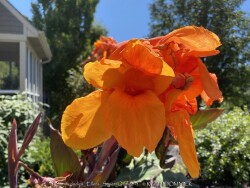

Cannas are typically grown for their continuous summer flowers and vertical wide-leaf foliage. The plants are large tropical and subtropical herbaceous perennials with a rhizomatous rootstock native to areas with a summer monsoon and dry winter. They can be grown as flowering summer patio plants. If growing as a potted plant and trying to overwinter, allowing the foliage to frost is ok, it will not kill the root system. However, do not allow the pot with rootball to freeze solid or go below 20 degrees for more than a few hours; move into a cold garage or basement over the winter with no watering. Cut back and allow to go dormant and place entire pot back out in April or May with a time-release fertilizer. Another more labor intensive way to overwinter cannas is to remove them from the dirt, dust with fungicide, place in box with sawdust, and keep in the refrigerator. We consider this method old-fashioned and too much work but ok if you only want to save a few pieces. If digging from the ground, just save a chunk with the dirt intact and place into a large pot in the garage. During the growing season, fertilize, water regularly, and place in full sun. You may also plant these in the ground for an enormous tropical effect! It is possible to overwinter these in the ground in Kansas by mulching 4-8" thick over deeply planted rhizomes. New growth will usually be slightly delayed but quick to regain full height. In our trial gardens in Lawrence, KS (zone 6a), the following varieties survived after being mulched 6-12" with leaf mulch to -17 degrees F. (Canna 'Daddy's Buckaroo',Canna 'Omega',Canna indica 'Red Stripe',Canna indica 'Ellen's Super Orange', Canna indica 'Wyoming') During the arctic blast of February, 2021, lows down to -17 degrees F on Feb 16th, 2021 were recorded. The longevity of this cold blast was also impressive: 10 days on a row with highs of 10-15 degrees F or lower, 8 nights of lows in the single digits and negatives, and 36 straight hours of 0 degrees F and mostly lower. Canna indica 'Ellen's Super Orange' is a tall variety with reddish-green leaves and bright orange flowers. This variety is among the most cold hardy of the cannas due to its vigorous deep growing rhizomes. Our original plant came from a residential garden in Lawrence, KS.
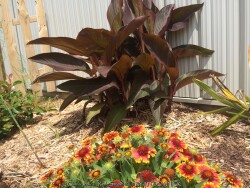

Cannas are typically grown for their continuous summer flowers and vertical wide-leaf foliage. The plants are large tropical and subtropical herbaceous perennials with a rhizomatous rootstock native to areas with a summer monsoon and dry winter. They can be grown as flowering summer patio plants. If growing as a potted plant and trying to overwinter, allowing the foliage to frost is ok, it will not kill the root system. However, do not allow the pot with rootball to freeze solid or go below 20 degrees for more than a few hours; move into a cold garage or basement over the winter with no watering. Cut back and allow to go dormant and place entire pot back out in April or May with a time-release fertilizer. Another more labor intensive way to overwinter cannas is to remove them from the dirt, dust with fungicide, place in box with sawdust, and keep in the refrigerator. We consider this method old-fashioned and too much work but ok if you only want to save a few pieces. If digging from the ground, just save a chunk with the dirt intact and place into a large pot in the garage. During the growing season, fertilize, water regularly, and place in full sun. You may also plant these in the ground for an enormous tropical effect! It is possible to overwinter these in the ground in Kansas by mulching 4-8" thick over deeply planted rhizomes. New growth will usually be slightly delayed but quick to regain full height. In our trial gardens in Lawrence, KS (zone 6a), the following varieties survived after being mulched 6-12" with leaf mulch to -17 degrees F. (Canna 'Daddy's Buckaroo',Canna 'Omega',Canna indica 'Red Stripe',Canna indica 'Ellen's Super Orange', Canna indica 'Wyoming') During the arctic blast of February, 2021, lows down to -17 degrees F on Feb 16th, 2021 were recorded. The longevity of this cold blast was also impressive: 10 days on a row with highs of 10-15 degrees F or lower, 8 nights of lows in the single digits and negatives, and 36 straight hours of 0 degrees F and mostly lower. Canna indica 'Red Stripe' is a medium variety with reddish-green leaves and red flowers.
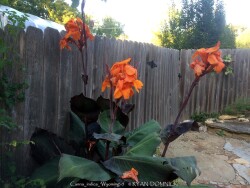

Cannas are typically grown for their continuous summer flowers and vertical wide-leaf foliage. The plants are large tropical and subtropical herbaceous perennials with a rhizomatous rootstock native to areas with a summer monsoon and dry winter. They can be grown as flowering summer patio plants. If growing as a potted plant and trying to overwinter, allowing the foliage to frost is ok, it will not kill the root system. However, do not allow the pot with rootball to freeze solid or go below 20 degrees for more than a few hours; move into a cold garage or basement over the winter with no watering. Cut back and allow to go dormant and place entire pot back out in April or May with a time-release fertilizer. Another more labor intensive way to overwinter cannas is to remove them from the dirt, dust with fungicide, place in box with sawdust, and keep in the refrigerator. We consider this method old-fashioned and too much work but ok if you only want to save a few pieces. If digging from the ground, just save a chunk with the dirt intact and place into a large pot in the garage. During the growing season, fertilize, water regularly, and place in full sun. You may also plant these in the ground for an enormous tropical effect! It is possible to overwinter these in the ground in Kansas by mulching 4-8" thick over deeply planted rhizomes. New growth will usually be slightly delayed but quick to regain full height. In our trial gardens in Lawrence, KS (zone 6a), the following varieties survived after being mulched 6-12" with leaf mulch to -17 degrees F. (Canna 'Daddy's Buckaroo',Canna 'Omega',Canna indica 'Red Stripe',Canna indica 'Ellen's Super Orange', Canna indica 'Wyoming') During the arctic blast of February, 2021, lows down to -17 degrees F on Feb 16th, 2021 were recorded. The longevity of this cold blast was also impressive: 10 days on a row with highs of 10-15 degrees F or lower, 8 nights of lows in the single digits and negatives, and 36 straight hours of 0 degrees F and mostly lower. Canna indica 'Wyoming' is a medium variety with reddish-green leaves and bright orange flowers.
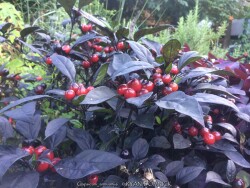

***Description for this plant available with future update!*** Capsicum annuum 'Black Pearl' is also known as Black Pearl Ornamental Pepper (Tropical).
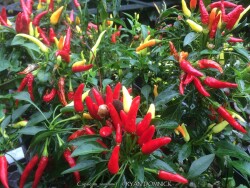

***Description for this plant available with future update!*** Capsicum annuum 'NuMex Easter' is also known as NuMex Easter Ornamental Pepper (Tropical).
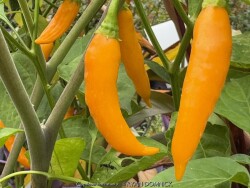

***Description for this plant available with future update!*** Capsicum baccatum 'Aji Amarillo' is also known as Aji Amarillo Peruvian Orange Pepper (Tropical).
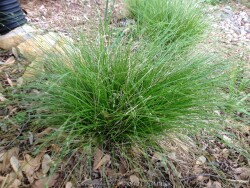

Carex appalachica, commonly called Appalachian Sedge, is native to It is native to the eastern North America, where its typical natural habitat is dry forests and woodlands. It forms a weed-suppressing grass-like clump 12" tall with brown seed heads dangling above. Bright green foliage is extremely fine-textured and hair-like. White-Tinged Sedge is one of the most drought tolerant of the sedges earning a spot in the dry shade garden; it cannot handle extreme drought or extremely rootbound soils though. Root rot can be a problem in poor drainage areas. It prefers average to dry garden conditions with dappled or morning sun. Sun burning is possible with temperatures over 100° so avoid full afternoon sun. Plantings can thrive for many years if in the right spot and there is no such thing as overcrowding. The growth rate is slow at first but eventually forms a nice weed resistant cover so space new plants relatively close together is desiring this effect.
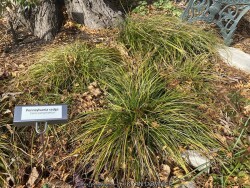

***Description for this grass available with future update!***>>>>>Oak Sedge (Carex pensylvanica) is planted for its attractive grass-like green foliage>>>>>. Foliage maintains well all year provided that certain cultural conditions are met. Carex plantaginea is native to rich deciduous forests in the eastern United States up to Canada. While it excels in moist shaded sites in calcareous soils, it can adapt to difficult dry shaded sites quite well once established. If low temperatures hit 5 degrees F, foliage finally back to the ground and re-emerges in early spring. Generally this plant can decline after a few years of Kansas climate but worth a try in reasonable soils in well-tended shade gardens. Tolerates moderate dry shade with regular weeding: competition with weeds seem to be an issue in low maintenance gardens.
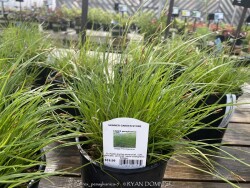

***Description for this grass available with future update!***>>>>>Oak Sedge (Carex pensylvanica) is planted for its attractive grass-like green foliage>>>>>. Foliage maintains well all year provided that certain cultural conditions are met. Carex plantaginea is native to rich deciduous forests in the eastern United States up to Canada. While it excels in moist shaded sites in calcareous soils, it can adapt to difficult dry shaded sites quite well once established. If low temperatures hit 5 degrees F, foliage finally back to the ground and re-emerges in early spring. Generally this plant can decline after a few years of Kansas climate but worth a try in reasonable soils in well-tended shade gardens. Tolerates moderate dry shade with regular weeding: competition with weeds seem to be an issue in low maintenance gardens.


The Saguaro Cactus (Carnegiea gigantea) is probably the most well known iconic cactus out there. Native to the Sonoran Desert in Arizona and Mexico, it's usually grown as a patio or house plant in Kansas. In the wild, established saguaro cacti are hardy to 15 degrees F for short periods of time making them the most cold tolerant columnar tree cactus out there. Growth rates are astonishingly slow: a plant the size od a softball may already be 10-15 years old. A 12" tall specimen may be 20-30 years old. The first arm usually develops around 75 years and plants can live for 200-300 years in hte wild. Grow in full sun with no extra watering except that which comes from rainfall. Repotting may or may not be needed depending on how large you want the plant to grow; plants can continue to grow taller and tolerate extremely root-bound pots but may need wind bracing. If repotting, make sure to use a sharp draining low organic cactus mix with plenty of sand and perlite. Potted plants are hardy to at least 30 degrees F for a short time if kept dry so you are ok if you miss the first light frost. Do not allow the pot with rootball to freeze solid though. Before extreme cold occurs, move to a bright interior window over the winter with no watering and keep above freezing. As a winter house plant, it will look presentable all winter long with just no waterings.(also to prevent soft winter growth) As a permanent house plant, provide bright light and allow the soil to dry between waterings for many years of carefree enjoyment. Plants grown permanently indoors may begin to elongate stretching for light and lose their spine color. It can be hard to reproduce the intense UV sunlight they need so moving outside for the summer is best. Generally if moving outside for the summer, allow 1-2 weeks of part shade or morning sun before placing in full sun. Plants with time to acclimate will thrive in full sun but be careful not to rush it or sunburning will occur. Potted plants are very low maintenance. I have never seen any insect problems on this plant.
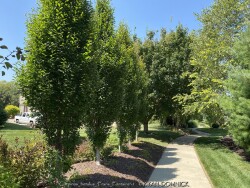

***Tree descriptions available with future update!*** Carpinus betulus 'Frans Fontaine' is also known as Frans Fontaine Columnar European Hornbeam
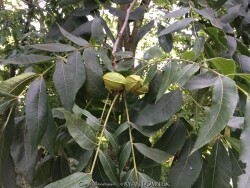

***Tree descriptions available with future update!*** Carya illinoinensis is also known as Hardy Pecan
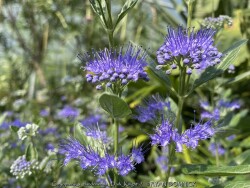

Dark Knight Caryopteris (Caryopteris x clandonensis 'Dark Knight') features darker green summer foliage followed by late-summer deep blue flowers and a compact growing habit. It adds much-needed color to the late summer landscape and makes a handsome companion with perennials. A great favorite with pollinators of all types (bees, butterflies, and hummingbirds) in the late season garden. Caryopteris demands a sunny spot and very well-drained soil. Wet soils, particularly those that remain soggy during periods of cold weather, will cause root rot. For this reason, we recommend early season planting of caryopteris in zones 5. In Eastern Kansas, this cultivar performs WELL with just about everything nature has to challenge it! Heat and drought are tolerated well. Cold tolerance is no problem for us in zone 6. Caryopteris gives great winter interest with it's dried flowers. The only maintenance this shrub needs is cutting back about 1/2 way in early spring before new growth emerges. No disease or pest problems. Great plant for berms or hot West or South exposures in full sun. Do not plant in rich moist soils or root rot will probably occur. Even when not blooming, the compact green foliage looks good on it's own or combines well with earlier season blooming red, purple, blue, or magenta flowering plants. Combine with crapemyrtles and butterflybush to create a late season "all you can eat" buffet for pollinators!
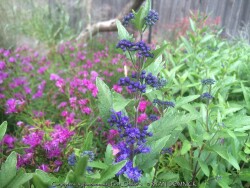

First Choice Caryopteris (Caryopteris x clandonensis 'First Choice') blooms earlier than other earlier caryopteris. This shrub develops a compact, tight habit with dark green foliage and deep blue long-lasting flowers. In Eastern Kansas, this cultivar performs WELL with just about everything nature has to challenge it! Heat and drought are tolerated well. Cold tolerance is no problem for us in zone 6. Caryopteris gives great winter interest with it's dried flowers. The only maintenance this shrub needs is cutting back about 1/2 way in early spring before new growth emerges. No disease or pest problems. Great plant for berms or hot West or South exposures in full sun. Do not plant in rich moist soils or root rot will probably occur. Even when not blooming, the compact green foliage looks good on it's own or combines well with earlier season blooming red, purple, blue, or magenta flowering plants. Combine with crape myrtles and butterfly bush to create a late season "all you can eat" buffet for pollinators!


Lil Miss Sunshine® Bluebeard (Caryopteris x clandonensis 'Lil Miss Sunshine') shows off vivid color from spring through frost! Among the most colorful of all garden plants, spring foliage emerges bright gold lasting all summer. In late summer, blue flowers begin to appear and persist through mid-autumn with unforgettable contrast. It's late season bloom time brings interest to the landscape when not much else is blooming and the nectar-rich flowers provide food for pollinating insects and hummingbirds. Compact size works well in perennial gardens or landscape beds. Excellent as part of the mixed border or in the perennial bed, it adds a shot of bold color to the late summer garden. Fertilize with a controlled release fertilizer in spring. In Eastern Kansas, this cultivar performs WELL with just about everything nature has to challenge it! Heat and drought are tolerated well. Cold tolerance is no problem for us in zone 6. Caryopteris gives great winter interest with it's dried flowers. Tip dieback is common after cold winters. The only maintenance this shrub needs is cutting back about 1/2 way in early spring before new growth emerges. In Northern areas it may die completely to the ground. The plant blooms on the current season's growth so will flower even if cut to the ground in spring. Great plant for berms or hot West or South exposures in full sun. No disease or pest problems except root rot; do not plant in rich moist soils or root rot will probably occur. Even when not blooming, the intense gold foliage looks good on it's own or combines well with earlier season blooming red, purple, blue, or magenta flowering plants. Combine with crapemyrtles and butterflybush to create a late season "all you can eat" buffet for pollinators! All Proven Winners® plants are legally propagated, healthy and vigorous, true to name, and tagged with color pictures and growing information.


Sunshine Blue® II Bluebeard (Caryopteris x clandonensis 'Sunshine Blue II') is the hardiest caryopteris yet! Sunshine Blue II is a new, improved variety of the classic Sunshine Blue, but it's much more tolerant of cold climates. If you've had trouble with bluebeard surviving winter in your area in the past, now's your chance to enjoy the vivid gold foliage and blue blooms of this late blooming favorite. An excellent plant for attracting pollinators! Top reasons to grow Sunshine Blue II caryopteris: 1.The hardiest caryopteris yet - survives winter even in the Midwest. 2.Colorful all season, especially late in summer when blue flowers appear. 3.Thrives in hot, dry, sunny spots. Maintenance Notes: Plant bluebeard in full sun and well-drained soil. Though Sunshine Blue II tolerates colder conditions than other caryopteris, it will do best if you avoid planting it in spots where the soil is cold or wet in winter and early spring. Cut back hard in spring, after the new growth emerges. Avoid late season planting in coldest parts of its hardiness range. In Eastern Kansas, this cultivar performs WELL with just about everything nature has to challenge it! Heat and drought are tolerated well. Cold tolerance is no problem for us in zone 6. Caryopteris gives great winter interest with it's dried flowers. The only maintenance this shrub needs is cutting back about 1/2 way in early spring before new growth emerges. No disease or pest problems. Great plant for berms or hot West or South exposures in full sun. Do not plant in rich moist soils or root rot will probably occur. Even when not blooming, the intense gold foliage looks good on it's own or combines well with earlier season blooming red, purple, blue, or magenta flowering plants. Combine with crapemyrtles and butterflybush to create a late season "all you can eat" buffet for pollinators! All Proven Winners® plants are legally propagated, healthy and vigorous, true to name, and tagged with color pictures and growing information.
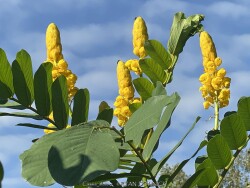

Yellow Candlestick Tree (Cassia / Senna alata) is grown in Kansas as a giant annual capable of reaching 6 to 12 feet in one season. Growth is slow at first in Spring when temperatures are still cool. It is native to tropical rainforests in Mexico and South America generally fulfilling the role of a pioneer species rapidly colonizing disturbed areas. Bright green bi-pinnate leaves are symmetrically arranged and very tropical looking. As branching and growth form develop, the overall geometrical effect is stunning even without flowers yet. Finally by September and all through October until frost, yellow candle-like flowers tower over the foliage. Some plants may have up to 50-100 flower spikes at one time. Cut down promptly after frost as there is no winter interest. Seeds rarely have time to develop in our shorter growing season but it is possible to harvest seeds if the first fall freeze is late. Yellow Candlestick Tree grows fastest in rich well drained soils and plenty of water. Growth is equally impressive in most Kansas soils including heavy clay as long as watering is sufficient. Yellow Candlestick Tree needs hot summers, full sun, and warm humid conditions to thrive. When grown in a large pot, it is very difficult to overwinter inside so it's best to buy new plants each year. This plant has also evolved and interesting relationship with ants, providing nectary glands (food) in exchange for protection from insect pests. Use Yellow Candlestick Tree where you need to fill up a lot of space in a hurry or just like lots of yellow flowers in the fall when other things are not blooming. Interestingly, the foliage is sensitive to light, folding up neatly at sunset and opening up the nest morning.
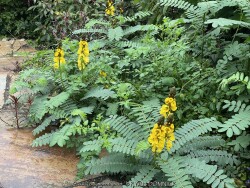

***Description for this plant available with future update!*** Cassia didymobotrya is also known as Popcorn Plant (Tropical).
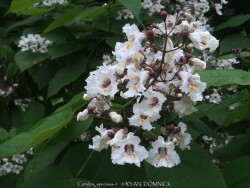

***Tree descriptions available with future update!*** Catalpa speciosa is also known as Northern Catalpa
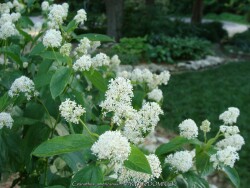

***Shrub descriptions available with future update!*** Ceanothus americanus is also known as New Jersey Tea.
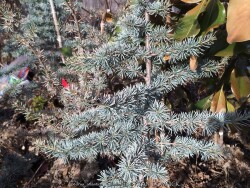

Blue Atlas Cedar (Cedrus atlantica 'Glauca') is an outstanding ornamental conifer tree with the characteristic conical shape and bluish-silver color. Foliage density is very compact along the branches but with plenty of space between branches, enough to show off the wonderful architectural branching structure of the tree. It is cold and drought tolerant enough to survive in much of Kansas with mature specimens (15-30' tall) occasionally seen in Lawrence and Kansas City. In Eastern Kansas, typically our 40 inches of rainfall is sufficient without extra water if planted in good soils. Avoid poorly drained clay soils especially that hold water for more than a day. Numerous cultivar selections are available, many for improved blue color of the needles or different growth forms. There is at least one "weeping" selection that I have witnessed prospering in Lawrence, KS for many years surviving -16 degrees F and a week of single digit highs in February, 2021.
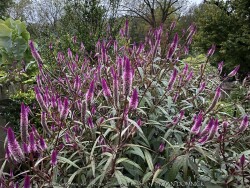

Flamingo Feather Celosia (Celosia argentea var. spicata 'Flamingo Feather') is a large magenta flowering annual. Growth starts off in May when temperatures have warmed. Beautiful dark green foliage has reddish colored back sides of the leaf and magenta stems. After achieving about 3 to 4 feet in height and wide, fuzzy magenta flower spikes begin to appear usually by July. Ultimate height can reach 5-6 feet as flowering becomes more dense and continues until frost providing an excellent long-lasting show. Celosia has little winter interests so you may cut down promptly after the first fall freeze. This is a time to save some of the seeds if you wish to sprinkle them in a new area next year. You may or may not enjoy the fact that the Celosia will easily re-seed itself in areas that you do not mulch. Seedlings come up rather late and can create a carpet under the previous years planting location. We usually allow self-seeding to occur in our display garden in select areas and then spray Roundup or mulch wherever you do not want seedlings. Flamingo Feather Celosia needs full sun for best flowering but tolerated virtually any soil conditions including compacted driveway gravel. Use Flamingo Feather Celosia where you need to fill up a lot of space in a hurry or just like lots of magenta flowers in the fall when other things are not blooming. Celosia is also grown as a food crop in Africa and Southeast Asia.
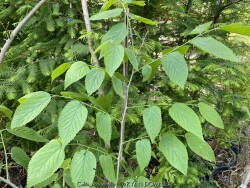

***Tree descriptions available with future update!***Hackberry, is also known as Celtis occidentalis
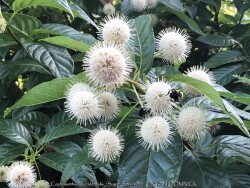

Button bush (Cephalanthus occidentalis) is a beautiful rounded shrub with glossy green leaves that turn reddish maroon in fall. White flowers are very unique (and look like a coronavirus) consisting of small spheres with protruding anthers. Bloom occurs all summer and are attractive to many different bee and butterfly species, including the swallowtail butterfly. Red fruiting heads appear in late summer adding to the ornamental appeal! In its native habitat covering most of Eastern United States including disjunct populations in Arizona, California, and Mexico, this wetland shrub can be found in low-lying areas. This includes swamps, marshes, bogs, wetlands, and along the edges of ponds, streams, and rivers. In Eastern Kansas, this is a no-brainer shrub to small tree for average garden soils including heavy clay and useful for rain gardens. Adapts to a wide range of soils except dry ones if in poor soils. Tolerant of moderate drought once established especially if in moisture-retentive rich soils. As a testament to this plants survivability, Clinton Lake and Perry Lake located in NE kansas flooded in 2020 with areas of shore-line underwater for the entire growing season. This killed every other plant species was killed except for buttonbush: all top growth was killed but new shoots from the root systems of thousands of plants along the shore resumed the following year when water receded. Basically, these plants survived over 18 months with no growth from fall of 2019 to spring of 2021. This plant can also grow in permanent standing water or as a potted plant in water gardens. Sugar Shack® Buttonbush (Cephalanthus occidentalis 'Sugar Shack') in a new Proven Winners variety! Although buttonbush has long been prized as a native and great for rain gardens, it was way too big for most landscapes. Not anymore! They cut the size in half and added improved colorful red fruit and glossy foliage. Add in cool looking, fragrant white flowers and you've got a delightful plant that shines from spring to fall. Blooming on new wood, button bush may be trimmed in early spring. Complete rejuvenation may also be done if plants get too big.
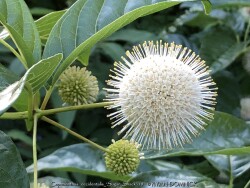

Button bush (Cephalanthus occidentalis) is a beautiful rounded shrub with glossy green leaves that turn reddish maroon in fall. White flowers are very unique (and look like a coronavirus) consisting of small spheres with protruding anthers. Bloom occurs all summer and are attractive to many different bee and butterfly species, including the swallowtail butterfly. Red fruiting heads appear in late summer adding to the ornamental appeal! In its native habitat covering most of Eastern United States including disjunct populations in Arizona, California, and Mexico, this wetland shrub can be found in low-lying areas. This includes swamps, marshes, bogs, wetlands, and along the edges of ponds, streams, and rivers. In Eastern Kansas, this is a no-brainer shrub to small tree for average garden soils including heavy clay and useful for rain gardens. Adapts to a wide range of soils except dry ones if in poor soils. Tolerant of moderate drought once established especially if in moisture-retentive rich soils. As a testament to this plants survivability, Clinton Lake and Perry Lake located in NE kansas flooded in 2020 with areas of shore-line underwater for the entire growing season. This killed every other plant species was killed except for buttonbush: all top growth was killed but new shoots from the root systems of thousands of plants along the shore resumed the following year when water receded. Basically, these plants survived over 18 months with no growth from fall of 2019 to spring of 2021. This plant can also grow in permanent standing water or as a potted plant in water gardens. Sugar Shack® Buttonbush (Cephalanthus occidentalis 'Sugar Shack') in a new Proven Winners variety! Although buttonbush has long been prized as a native and great for rain gardens, it was way too big for most landscapes. Not anymore! They cut the size in half and added improved colorful red fruit and glossy foliage. Add in cool looking, fragrant white flowers and you've got a delightful plant that shines from spring to fall. Blooming on new wood, button bush may be trimmed in early spring. Complete rejuvenation may also be done if plants get too big.
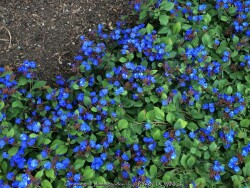

Creeping Plumbago / Leadwort (Ceratostigma plumbaginoides) is a Chinese native plant well adapted to our climate without being invasive in Kansas. It features nonstop royal blue flowers from midsummer till hard freeze; Usually three months or more. After a first light freeze, if flowering is still occurring, rich green foliage will turn bright red while still containing a few blue flowers. This creates a one-of-a-kind contrast not seen in any other plants. Plumbago combines well with just about any other plant due to its rare flower color. This is especially dramatic is combining it with opposites on the color wheel like orange, red or yellow. Growth is often slow to emerge in the spring as plumbago needs warmer soil than most other plants to start growing. This allows for a good combination for spring bulbs to grow with plumbago coming up later to hide the dying bulb foliage. In Kansas landscapes, plumbago is often used as a full sun groundcover in hot areas such as west or south side of the house. Normal garden conditions and berms are fine as well. Plants can survive and flower in shade but growth will be much slower and risk of death will be present until established. In zone 6a, all plantings should be mulched and only larger size established pots should be planted if in the fall. Plumbago sold in flats of many smaller plants can safely be planted in spring or summer. Plumbago needs medium to dry soil tolerating clay as long as everything as well-drained. Once plants are established for a season or two in full sun, they are nearly indestructible. Slow spread will occur and plants will develop very high density smothering out weeds. Sometimes the slowly spreading growth (underground rhizones) can be a problem after a decade or so. However, if you plan ahead and use it as a groundcover like intended, it will be perfect. Being a very low maintenance plant not requiring extra watering or deadheading, the only thing you need to do is weed-eat or cut back all the foliage in the winter. Plumbago has no pest or disease problems.
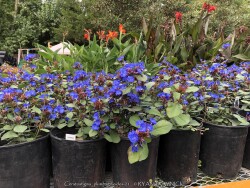

Creeping Plumbago / Leadwort (Ceratostigma plumbaginoides) is a Chinese native plant well adapted to our climate without being invasive in Kansas. It features nonstop royal blue flowers from midsummer till hard freeze; Usually three months or more. After a first light freeze, if flowering is still occurring, rich green foliage will turn bright red while still containing a few blue flowers. This creates a one-of-a-kind contrast not seen in any other plants. Plumbago combines well with just about any other plant due to its rare flower color. This is especially dramatic is combining it with opposites on the color wheel like orange, red or yellow. Growth is often slow to emerge in the spring as plumbago needs warmer soil than most other plants to start growing. This allows for a good combination for spring bulbs to grow with plumbago coming up later to hide the dying bulb foliage. In Kansas landscapes, plumbago is often used as a full sun groundcover in hot areas such as west or south side of the house. Normal garden conditions and berms are fine as well. Plants can survive and flower in shade but growth will be much slower and risk of death will be present until established. In zone 6a, all plantings should be mulched and only larger size established pots should be planted if in the fall. Plumbago sold in flats of many smaller plants can safely be planted in spring or summer. Plumbago needs medium to dry soil tolerating clay as long as everything as well-drained. Once plants are established for a season or two in full sun, they are nearly indestructible. Slow spread will occur and plants will develop very high density smothering out weeds. Sometimes the slowly spreading growth (underground rhizones) can be a problem after a decade or so. However, if you plan ahead and use it as a groundcover like intended, it will be perfect. Being a very low maintenance plant not requiring extra watering or deadheading, the only thing you need to do is weed-eat or cut back all the foliage in the winter. Plumbago has no pest or disease problems.
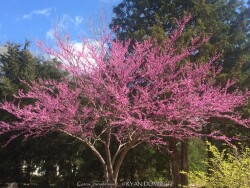

***Tree descriptions available with future update!***Eastern Redbud, is also known as Cercis canadensis
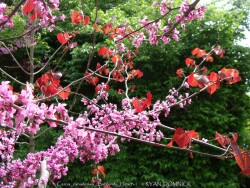

Cercis canadensis Burgundy Hearts® is an improved reddish purple-leaf variety developed by Greenleaf Nurseries in Oklahoma. Burgundy Hearts more drought and heat tolerant. Pinkish-lavender April flowers bloom for about a month before leaves appear. It has a more or less rounded form, wider than it is tall. This small deciduous tree is known for its heart-shaped leaves that hold their dark color longer in the summer, taking on reddish wine tones towards the fall. Many of the problems with the regular species redbud tree are not an issue with this improved cultivar. It is to be expected however that all Redbuds have a relatively short lifespan of 20-40 years but even so, are worth planting for its beautiful flowers. It is not weak wooded and makes a nice hot non-sparking firewood. The short life span is not due to breakage so much as it is to the tree's susceptibility to heart-rot especially when branch crotches form and get older. Other problems include canker, verticillium wilt and root rot. Most redbud varieties thrive in full sun to partial shade. They will tolerate full shade but become elongated and thin as they reach for the sun. Redbuds do well in most soil types but adequate drainage is a must; it can tolerate dry shade of Eastern Kansas forests receiving at least 35" of rainfall per year. The species is a native from southern Canada to Florida, east to Kansas. The regular species also has the potential to self seed in your yard but not Burgundy Hearts. As a dwarf tree, use 'Merlot' as a specimen or part of a group. It reaches about 20 to 30 feet high and wide in full sun. Reddish leaf color emerges in the spring and is maintained all summer long if in mostly full sun. The color of older purple redbuds (like Forest Pansy) fades to dark green as the summer heat intensifies.
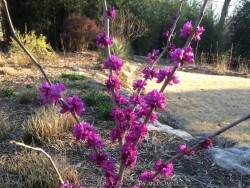

Don Egolf Redbud (Cercis canadensis 'Don Egolf') is a dwarf flowering shrub redbud native to China. It has the typical heart shaped green Redbud foliage and deep magenta flowers. The bark is more of a beige or light tan color with black buds. Flowering begins in April with flower buds starting on old wood all the way to the ground level. Flowering even occurs on very young plants only several inches tall. Because this is a Chinese species, no seed pods form like on native Redbuds. After many years, heights of 8 to 10 feet may be achieved on multi-stemmed plants. Culture conditions are pretty easy; just provide average garden soil, reasonable water, and mostly sun. In Eastern Kansas, typically our 40 inches of rainfall is sufficient without extra water if planted in good soils. Don Eagles Red has been growing in our display garden for over 10 years blooming consistently with no problems. It survived -16 degrees F and a week of single digit highs in February, 2021 with no damage to flower buds.
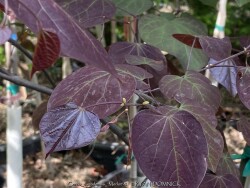

This purple-leaf Redbud (Cercis canadensis 'Merlot') is a canadensis and texensis cross to produce a more drought and heat tolerant tree. It has glossy, small rounded dark purple leaves and has an upright vase-shaped growth habit. This small deciduous tree is known for its stunning display of colorful blooms a deep magenta color. Many of the problems with the regular species redbud tree are not an issue with this improved cultivar. It is to be expected however that all Redbuds have a relatively short lifespan of 20-40 years but even so, are worth planting for its beautiful flowers. It is not weak wooded and makes a nice hot non-sparking firewood. The short life span is not due to breakage so much as it is to the tree's susceptibility to heart-rot especially when branch crotches form and get older. Other problems include canker, verticillium wilt and root rot. Most redbud varieties thrive in full sun to partial shade. They will tolerate full shade but become elongated and thin as they reach for the sun. Redbuds do well in most soil types but adequate drainage is a must; it can tolerate dry shade of Eastern Kansas forests receiving at least 35" of rainfall per year. The species is a native from southern Canada to Florida, east to Kansas. The regular species also has the potential to self seed in your yard but not 'Merlot'. As a dwarf tree, use 'Merlot' as a specimen or part of a group. It reaches about 12 to 15 feet high and wide in full sun. Reddish leaf color emerges in the spring and is maintained all summer long if in mostly full sun. The color of older purple redbuds (like Forest Pansy) fades to dark green as the summer heat intensifies.
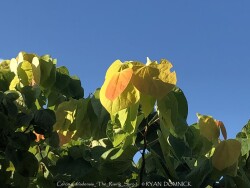

***Tree descriptions available with future update!*** Cercis canadensis 'The Rising Sun' is also known as Rising Sun Gold-Leaf Redbud
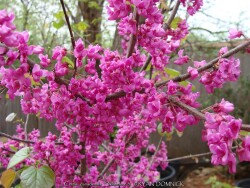

***Tree descriptions available with future update!*** Cercis canadensis ssp texensis 'Oklahoma' is also known as Oklahoma Redbud
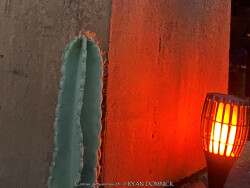

Grown for its beautiful bluish-green skin and showy night-blooming white flowers. Unlike most columnar cacti, Peruvian apple cactus (Cereus peruvianus) will bloom at a young age in a pot when about 3' tall or more. This cactus is usually grown as a patio or house plant in Kansas and blooms in late summer into early fall. Flowers only last one night! In the wild, this species is hardy to 20-25 degrees F for short periods of time. Grow in full sun with optional extra watering including that which comes from rainfall. Potted plants are very low maintenance. I have never seen any insect problems on this plant. Potted plants are capable of growing 10' tall or more in a small 7gal pot. Succulents are usually spineless and grown for their beautiful shapes, color and texture. Cacti are known for their spines, unusual shapes and beautiful flowers. Both succulents and cacti store water in their fleshy tissues. And can survive long periods without water. Cacti and succulents are usually grown as a deck/patio plant or house plant in Kansas. Grow in full sun with little to no extra watering except that which comes from rainfall. Generally, plants may be brought out in Late May through Early October in our zone 6a Lawrence, KS climate. To play is safe, potted plants are best moved in before autumn leaves begin to drop and before night temperatures get below 45 degrees F. It is very important to avoid the combination of wet and cold. Move to a bright interior window over the winter with little to no watering and keep above 50 degrees F. As a winter house plant, it will look presentable all winter long with little to no waterings. As a permanent house plant, provide bright light and allow the soil to dry completely between waterings and you will get many years of carefree enjoyment. Plants grown permanently indoors may eventually begin to elongate stretching for light and lose their spine color. It can be hard to reproduce the intense UV sunlight they need when growing indoors so moving outside for the summer is best. Generally if moving outside for the summer, allow 1-2 weeks of part shade or morning sun before placing in full sun. Plants with time to acclimate will thrive in full sun but be careful not to rush it or sunburning may occur. Repotting may or may not be needed depending on how large you want the plant to grow; plants can continue to grow taller and tolerate extremely root-bound pots but may need wind bracing. If repotting, make sure to use a sharp draining low organic cactus mix with plenty of sand and perlite but avoid peat moss. The “soil” most commercial cacti are potted in to too peaty and light weight. This soil becomes hydrophobic and shrinks after becoming bone dry and difficult to re wet again. Cacti never grow in peat-based soils in nature; this “Soil” is only good for shipping because of the light weight. Potted plants are very low maintenance but watch for scale and mealybugs that may hide beneath the cover of spines. The best pest removal approach is to periodically wash the cactus off. Achieve this with a water nozzle or hose breaker turned mostly off to increase the pressure from the blast of water. This high-pressured water kills the pests without damaging the thick cactus skin. Here are some little-known or rare factoids about cacti: 1. The "spines" are actually modified leaves filled with sap at first, then quickly drying out to form the spines! 2. Many cacti have bright colored flowers that mainly attract bees, while some tubular flowering types attract hummingbirds and bats. 3. Late on the evolutionary timeline, cacti fossils are rare to non-existent. Cacti are native almost exclusively to the Americas, while succulents can include a much larger plant palette be from any dry area in the world. 4. Some cactus plants have been known to survive more than 2 years without water. 5. Some cacti first evolved in a dry climate that later became wetter again. For example: several jungle species live as epiphytes in trees to achieve the fast drainage they need.


Grown for its beautiful bluish-green skin and showy night-blooming white flowers. Unlike most columnar cacti, Peruvian apple cactus (Cereus peruvianus) will bloom at a young age in a pot when about 3' tall or more. This cactus is usually grown as a patio or house plant in Kansas and blooms in late summer into early fall. Flowers only last one night! In the wild, this species is hardy to 20-25 degrees F for short periods of time. Grow in full sun with optional extra watering including that which comes from rainfall. Potted plants are very low maintenance. I have never seen any insect problems on this plant. Potted plants are capable of growing 10' tall or more in a small 7gal pot. Succulents are usually spineless and grown for their beautiful shapes, color and texture. Cacti are known for their spines, unusual shapes and beautiful flowers. Both succulents and cacti store water in their fleshy tissues. And can survive long periods without water. Cacti and succulents are usually grown as a deck/patio plant or house plant in Kansas. Grow in full sun with little to no extra watering except that which comes from rainfall. Generally, plants may be brought out in Late May through Early October in our zone 6a Lawrence, KS climate. To play is safe, potted plants are best moved in before autumn leaves begin to drop and before night temperatures get below 45 degrees F. It is very important to avoid the combination of wet and cold. Move to a bright interior window over the winter with little to no watering and keep above 50 degrees F. As a winter house plant, it will look presentable all winter long with little to no waterings. As a permanent house plant, provide bright light and allow the soil to dry completely between waterings and you will get many years of carefree enjoyment. Plants grown permanently indoors may eventually begin to elongate stretching for light and lose their spine color. It can be hard to reproduce the intense UV sunlight they need when growing indoors so moving outside for the summer is best. Generally if moving outside for the summer, allow 1-2 weeks of part shade or morning sun before placing in full sun. Plants with time to acclimate will thrive in full sun but be careful not to rush it or sunburning may occur. Repotting may or may not be needed depending on how large you want the plant to grow; plants can continue to grow taller and tolerate extremely root-bound pots but may need wind bracing. If repotting, make sure to use a sharp draining low organic cactus mix with plenty of sand and perlite but avoid peat moss. The “soil” most commercial cacti are potted in to too peaty and light weight. This soil becomes hydrophobic and shrinks after becoming bone dry and difficult to re wet again. Cacti never grow in peat-based soils in nature; this “Soil” is only good for shipping because of the light weight. Potted plants are very low maintenance but watch for scale and mealybugs that may hide beneath the cover of spines. The best pest removal approach is to periodically wash the cactus off. Achieve this with a water nozzle or hose breaker turned mostly off to increase the pressure from the blast of water. This high-pressured water kills the pests without damaging the thick cactus skin. Here are some little-known or rare factoids about cacti: 1. The "spines" are actually modified leaves filled with sap at first, then quickly drying out to form the spines! 2. Many cacti have bright colored flowers that mainly attract bees, while some tubular flowering types attract hummingbirds and bats. 3. Late on the evolutionary timeline, cacti fossils are rare to non-existent. Cacti are native almost exclusively to the Americas, while succulents can include a much larger plant palette be from any dry area in the world. 4. Some cactus plants have been known to survive more than 2 years without water. 5. Some cacti first evolved in a dry climate that later became wetter again. For example: several jungle species live as epiphytes in trees to achieve the fast drainage they need.
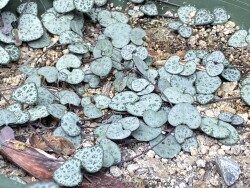

Ceropegia woodii known as the Rosary Vine and String of Hearts. This unusual, hardy vining succulent produces pretty, variegated, heart-shaped leaves with purple undersides on tough, wire-like stems. They are usually grown as a patio or house plant in Kansas. String of Hearts also grow well in hanging baskets as a durable, succulent plant able to survive drying out, heat and dry air like few others! If conditions get too rough, the foliage simply dies back and growth returns from underground tubers when favorable conditions return. To play is safe, potted plants are best moved in before night temperatures get below 45 degrees F. It is important to avoid the combination of wet and cold. Before extreme cold occurs, move to a bright interior window over the winter with no watering and keep above freezing. As a winter house plant, it will look presentable all winter long with just no waterings. As a permanent house plant, provide bright light and allow the soil to dry between waterings for many years of carefree enjoyment. Plants grown permanently indoors may begin to elongate stretching for light producing weak new growth. It can be hard to reproduce the intense UV sunlight they need so moving outside for the summer is best. Generally if moving outside for the summer, allow 1-2 weeks of part shade or morning sun before placing in full sun. Plants with time to acclimate will thrive in full sun but be careful not to rush it or sunburning will occur. Potted plants are very low maintenance. I have never seen any insect problems on this plant.
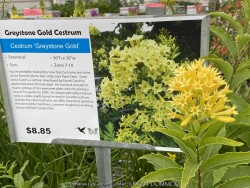

Jessamine / Hardy Cestrums are relatively new and upcomming plant. Our mix of species were purchased from Bustani Plant Farm in Stillwater, OK. Mostly listed as hardy to zone 7, you can easily push this into zone 6 with a layer of thick winter mulch. Mix of the following species proven hardy in Lawrence, KS: Cestrum aurantiacum, Cestrum ‘Greystone Gold’, Cestrum ‘Orange Peel’. Many visitors in the display garden are amazed by the uniqueness and beauty. It really resembles a "yellow flowering lilac" with flowers and foliage. Similar to a Crapemyrtle, These Cestrum varieties are hardy outside when grown as a perennial and cut back hard each year. During the growing season, fertilize, water regularly, and plant in full sun. Plant a little deep at first; about 2-3" deep with 4-6" of mulch. In our trial gardens in Lawrence, KS (zone 6a), the following varieties survived after being mulched 6-12" with leaf mulch. During the arctic blast of January, 2024, lows down to -11 degrees F on Jan 10th, 2024 were recorded. The longevity of this cold blast was also impressive: 4 days on a row with single digit highs including 1 day with a negative high(-2F), 4 nights of lows in negatives(-8For lower), and 48 straight hours of 0 degrees F and mostly lower.
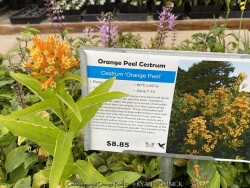

Jessamine / Hardy Cestrums are relatively new and upcomming plant. Our mix of species were purchased from Bustani Plant Farm in Stillwater, OK. Mostly listed as hardy to zone 7, you can easily push this into zone 6 with a layer of thick winter mulch. Mix of the following species proven hardy in Lawrence, KS: Cestrum aurantiacum, Cestrum ‘Greystone Gold’, Cestrum ‘Orange Peel’. Many visitors in the display garden are amazed by the uniqueness and beauty. It really resembles a "yellow flowering lilac" with flowers and foliage. Similar to a Crapemyrtle, These Cestrum varieties are hardy outside when grown as a perennial and cut back hard each year. During the growing season, fertilize, water regularly, and plant in full sun. Plant a little deep at first; about 2-3" deep with 4-6" of mulch. In our trial gardens in Lawrence, KS (zone 6a), the following varieties survived after being mulched 6-12" with leaf mulch. During the arctic blast of January, 2024, lows down to -11 degrees F on Jan 10th, 2024 were recorded. The longevity of this cold blast was also impressive: 4 days on a row with single digit highs including 1 day with a negative high(-2F), 4 nights of lows in negatives(-8For lower), and 48 straight hours of 0 degrees F and mostly lower.
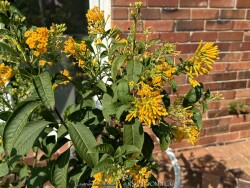

Jessamine / Hardy Cestrums are relatively new and upcomming plant. Our mix of species were purchased from Bustani Plant Farm in Stillwater, OK. Mostly listed as hardy to zone 7, you can easily push this into zone 6 with a layer of thick winter mulch. Mix of the following species proven hardy in Lawrence, KS: Cestrum aurantiacum, Cestrum ‘Greystone Gold’, Cestrum ‘Orange Peel’. Many visitors in the display garden are amazed by the uniqueness and beauty. It really resembles a "yellow flowering lilac" with flowers and foliage. Similar to a Crapemyrtle, These Cestrum varieties are hardy outside when grown as a perennial and cut back hard each year. During the growing season, fertilize, water regularly, and plant in full sun. Plant a little deep at first; about 2-3" deep with 4-6" of mulch. In our trial gardens in Lawrence, KS (zone 6a), the following varieties survived after being mulched 6-12" with leaf mulch. During the arctic blast of January, 2024, lows down to -11 degrees F on Jan 10th, 2024 were recorded. The longevity of this cold blast was also impressive: 4 days on a row with single digit highs including 1 day with a negative high(-2F), 4 nights of lows in negatives(-8For lower), and 48 straight hours of 0 degrees F and mostly lower.
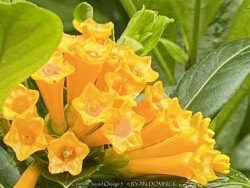

Jessamine / Hardy Cestrums are relatively new and upcomming plant. Brighten up summertime with Juiced® Orange jessamine. This compact hybrid jessamine has deliciously colorful blooms and bright glossy foliage. These citrus-hued, tubular flowers attract both butterflies and hummingbirds. Blooming from spring to frost, this tropical evergreen has dark, glossy foliage and a superior, bushy habit along with easy care: no need to trim to keep the blooms coming! In colder climates, it can be grown as a patio plant and overwintered in a sunroom. This is a fun and colorful South American native that offers uniqueness and novelty that everyone will crave. Mostly listed as hardy to zone 7, you can easily push this into zone 6 with a layer of thick winter mulch. Many visitors in the display garden are amazed by the uniqueness and beauty. It really resembles a "yellow flowering lilac" with flowers and foliage. Similar to a Crapemyrtle, Cestrums are hardy outside when grown as a perennial and cut back hard each year. It will re-grow from the roots and still flower on new wood by mid-summer. During the growing season, fertilize, water regularly, and plant in full sun. Plant a little deep at first; about 2-3" deep with 4-6" of mulch. In our trial gardens in Lawrence, KS (zone 6a), the following varieties survived after being mulched 6-12" with leaf mulch. During the arctic blast of January, 2024, lows down to -11 degrees F on Jan 10th, 2024 were recorded. The longevity of this cold blast was also impressive: 4 days on a row with single digit highs including 1 day with a negative high(-2F), 4 nights of lows in negatives(-8For lower), and 48 straight hours of 0 degrees F and mostly lower. PROVEN WINNERS variety.


Jessamine / Hardy Cestrums are relatively new and upcomming plant. Our mix of species were purchased from Bustani Plant Farm in Stillwater, OK. Mostly listed as hardy to zone 7, you can easily push this into zone 6 with a layer of thick winter mulch. Mix of the following species proven hardy in Lawrence, KS: Cestrum aurantiacum, Cestrum ‘Greystone Gold’, Cestrum ‘Orange Peel’. Many visitors in the display garden are amazed by the uniqueness and beauty. It really resembles a "yellow flowering lilac" with flowers and foliage. Similar to a Crapemyrtle, These Cestrum varieties are hardy outside when grown as a perennial and cut back hard each year. During the growing season, fertilize, water regularly, and plant in full sun. Plant a little deep at first; about 2-3" deep with 4-6" of mulch. In our trial gardens in Lawrence, KS (zone 6a), the following varieties survived after being mulched 6-12" with leaf mulch. During the arctic blast of January, 2024, lows down to -11 degrees F on Jan 10th, 2024 were recorded. The longevity of this cold blast was also impressive: 4 days on a row with single digit highs including 1 day with a negative high(-2F), 4 nights of lows in negatives(-8For lower), and 48 straight hours of 0 degrees F and mostly lower.
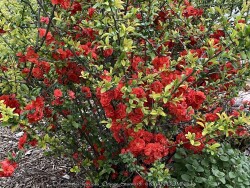

Double Take® Orange Quince (Chaenomeles 'Double Take Orange') features huge flowers on a thornless plant. It's so beautiful you may overlook its survivalist skills! Heat and drought tolerant, this plant will delight you each spring with candy colored blooms. Double Take Orange puts on a spectacular spring display of large double flowers with intense orange color - you'll do a double take! More than just pretty flowers, the Double Take Quinces are easy to care for, having neither thorns or fruit. Once established, they are extremely drought tolerant. Developed by Dr. Tom Ranney and his team at the Mountain Crops Research & Extension Center in beautiful North Carolina, Orange Storm and the other Double Take Quinces are sure to brighten spring gardens across the United States. Uses Notes: Excellent for hedging, mass planting and cut flower gardens. A spectacular early season specimen for the mixed border. Maintenance Notes: Prune to shape after flowering. Apply a controlled release fertilizer in spring. Formerly known as Double Take 'Orange Storm' quince. In Eastern Kansas, this cultivar performs WELL with just about everything nature has to challenge it! Heat and drought are tolerated reasonably well but with some foliage decline by late summer and no fall color. This is made up for by the extremely reliable blooming season that fills up the month of April when many other plants are not in full swing yet. Cold tolerance or flower bud loss is no problem in our zone 6. No serious disease or pest problems. All Proven Winners® plants are legally propagated, healthy and vigorous, true to name, and tagged with color pictures and growing information.
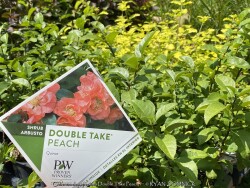

Double Take® Pink Quince (Chaenomeles 'Double Take Pink') features huge flowers on a thornless plant! You'll do a double take when you see this quince that looks like a camellia. Double Take Pink puts on a spectacular early season display of pink blooms. The large, double flowers are excellent in cut flower arrangements. Bright spring flowers are only the beginning of the Double Take quince's appeal: they're also thornless, and do not produce fruit. Extremely drought tolerant once established, these early spring charmers are excellent landscape plants and real survivalists in tough climates. Developed by Dr. Tom Ranney and his team at the Mountain Horticultural Crops Research & Extension Center in beautiful North Carolina, they are sure to brighten spring landscapes across the United States.Uses Notes: Intense early spring color is excellent for mixed borders and cutting gardens. Also good for hedging and mass plantings. Maintenance Notes: Trim to shape after flowering. Apply a controlled release fertilizer in spring. Formerly sold as Double Take 'Pink Storm' quince. In Eastern Kansas, this cultivar performs WELL with just about everything nature has to challenge it! Heat and drought are tolerated reasonably well but with some foliage decline by late summer and no fall color. This is made up for by the extremely reliable blooming season that fills up the month of April when many other plants are not in full swing yet. Cold tolerance or flower bud loss is no problem in our zone 6. No serious disease or pest problems. All Proven Winners® plants are legally propagated, healthy and vigorous, true to name, and tagged with color pictures and growing information.
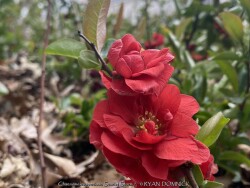

You'll do a double take when you see this quince that looks like a camellia. Double Take Scarlet Quince (Chaenomeles 'Double Take Scarlet') puts on a spectacular early spring display of large red, double flowers. The Double Take quinces are more than just pretty spring flowers: thornless and deer-resistant, they do not produce fruit, and once established, are drought-tolerant survivalists. Developed by Dr. Tom Ranney and his team at the Mountain Horticultural Crops Research & Extension Center in beautiful North Carolina, the Double Take quinces are sure to brighten spring landscapes across the United States. Uses Notes: Bright early spring flowers are great in mixed borders or cutting gardens. Also good for hedging and mass plantings. Maintenance Notes: Trim to shape after flowering. Apply a controlled release fertilizer in early spring. Formerly sold as Double Take 'Scarlet Storm' quince. In Eastern Kansas, this cultivar performs WELL with just about everything nature has to challenge it! Heat and drought are tolerated reasonably well but with some foliage decline by late summer and no fall color. This is made up for by the extremely reliable blooming season that fills up the month of April when many other plants are not in full swing yet. Cold tolerance or flower bud loss is no problem in our zone 6. No serious disease or pest problems. All Proven Winners® plants are legally propagated, healthy and vigorous, true to name, and tagged with color pictures and growing information.
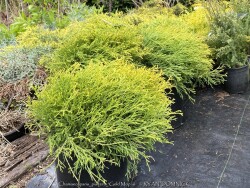

Gold Mop False Cypress (Chamaecyparis pisifera 'Gold Mop') is from a group of small coniferous shrubs from Asia with Juniper-like foliage. The foliage is bright yellow, thread-like and creates a relatively low, semi-weeping habit. It provides consistent color during spring, summer, fall, and darkens to a more gold color by winter providing excellent color when most other plants are dormant. Full sun and average garden conditions are preferred. Maintenance is pretty easy, only prune when needed to control size. Do not prune in late summer or fall. Coloring is definitely best if the plant can receive winter sun. Combine in the summer with other flowering perennials and shrubs. Combine in the winter with ornamental grasses, yuccas, Nandinas, or winter interest plants that contrast with gold.
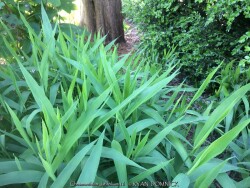

Northern / Inland Sea Oats (Chasmanthium latifolium) is a grass native to the central and eastern United States including some areas in the southwest. Sea Oats is grown is notable for its large graceful seedheads and ability to tolerate full shade. Sending up blue-green spools of basal leaves in spring, it will grow to 2 feet tall with green seed heads starting to form earlier than most other grasses. As it turns a vivid green by June, the translucent green seedheads swaying in the breeze. By mid-summer, the seeds will have turned an attractive ivory and will turn brown in a few months before dropping off in fall. It looks attractive into late fall but becomes tattered after seeds drop making it a good grass to cut back in the late fall or early winter instead of Spring. For the home garden in rich well irrigated areas, this species can be too aggressive from self-seeding to mix with other plants. Use as a mass planting in any shaded area allowing extra room. However, in a difficult dry-shade garden, it will thrive, flower, and be relatively tame without much spread. Mulch will also stop self-seeding. It is one of the few plants that can survive under an established Silver Maple! Now if you need a plant to prevent soil erosion along streams, use this reseeding to your advantage! As it reseeds easily and can expand aggressively within a couple of years, it makes a solid root mat in moist erosion-prone loam soils.
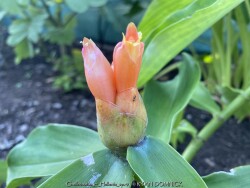

***Description for this plant available with future update!*** Cheilocostus / Hellenia sp is also known as Crepe Ginger (Tropical).
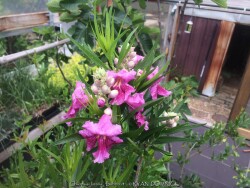

Desert Willow is a small open irregularly branched tree or large shrub with bright green narrow leaves (but not related to true willows) It features gorgeous pink, white and magenta snapdragon-like flowers with yellow throats. Blooming season is immensely long beginning in June continuing all summer until frost. Desert Willow grows in all soil types here in Kansas but prefers rich silty loam. It will not grow in excessively wet anaerobic soils though. Absolute full sun is needed for best growth to produce flowers and avoid spindlyness. In the landscape, Desert Willow can be used as a specimen shrub or small tree. It handles hot west for south locations very well. It's native range covers most of the Southwest and western Texas along streams and riparian areas. Being surprisingly cold hardy here, Several Desert Willow cultivars can be found at the Denver Botanic Gardens in Denver CO (zone 5b) and at the Dyck Arboretum in Hesston, Kansas (zone 6b). Bubba Desert Willow (Chilopsis linearis 'Bubba') has been thriving in our display garden and other Lawrence, KS locations for over 15 years and has endured temperatures as low as a -18. During the most severe winters, winter kills it down to the ground. However, just like Crapemyrtle or Butterfly Bush, Desert Willow blooms on new wood and at a young age with blooms even occurring on 3 foot tall nursery plants. Water sprout regrowth from established landscape plants is rapid with heights reaching 5-6'. These blooms are more numerous and larger than normal, especially with a handful of time-release fertilized applied in the early spring. Bubba Magenta Desert Willow (Chilopsis linearis 'Bubba') is a vigorous, fast-growing upright selection of desert willow that originated in Texas. Compared to other selections it has a strong vertical form and is less shrubby. It also has glossy, darker green, more lush foliage than other desert willows.
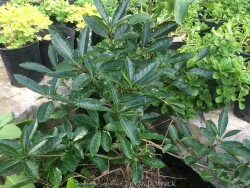

***Description for this plant available with future update!***Fringe Tree, is also known as Chionanthus virginicus
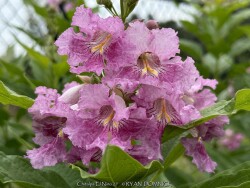

***Description for this hardy tropical available with future update!*** Chitalpa 'El Nino' / x Chitalpa 'El Nino' is also known as El Nino Desert Orchid >>>>>>>>>>>Desert Willow is a small open irregularly branched tree or large shrub with bright green narrow leaves (but not related to true willows) It features gorgeous pink, white and magenta snapdragon-like flowers with yellow throats. Blooming season is immensely long beginning in June continuing all summer until frost. Desert Willow grows in all soil types here in Kansas but prefers rich silty loam. It will not grow in excessively wet anaerobic soils though. Absolute full sun is needed for best growth to produce flowers and avoid spindlyness. In the landscape, Desert Willow can be used as a specimen shrub or small tree. It handles hot west for south locations very well. It's native range covers most of the Southwest and western Texas along streams and riparian areas. Being surprisingly cold hardy here, Several Desert Willow cultivars can be found at the Denver Botanic Gardens in Denver CO (zone 5b) and at the Dyck Arboretum in Hesston, Kansas (zone 6b). Bubba Desert Willow (Chilopsis linearis 'Bubba') has been thriving in our display garden and other Lawrence, KS locations for over 15 years and has endured temperatures as low as a -18. During the most severe winters, winter kills it down to the ground. However, just like Crapemyrtle or Butterfly Bush, Desert Willow blooms on new wood and at a young age with blooms even occurring on 3 foot tall nursery plants. Water sprout regrowth from established landscape plants is rapid with heights reaching 5-6'. These blooms are more numerous and larger than normal, especially with a handful of time-release fertilized applied in the early spring.